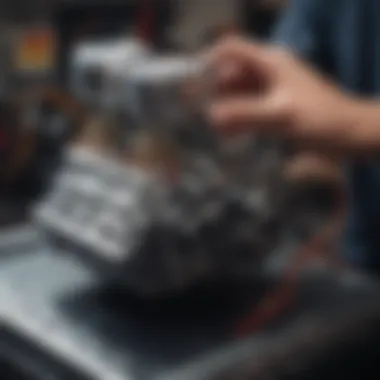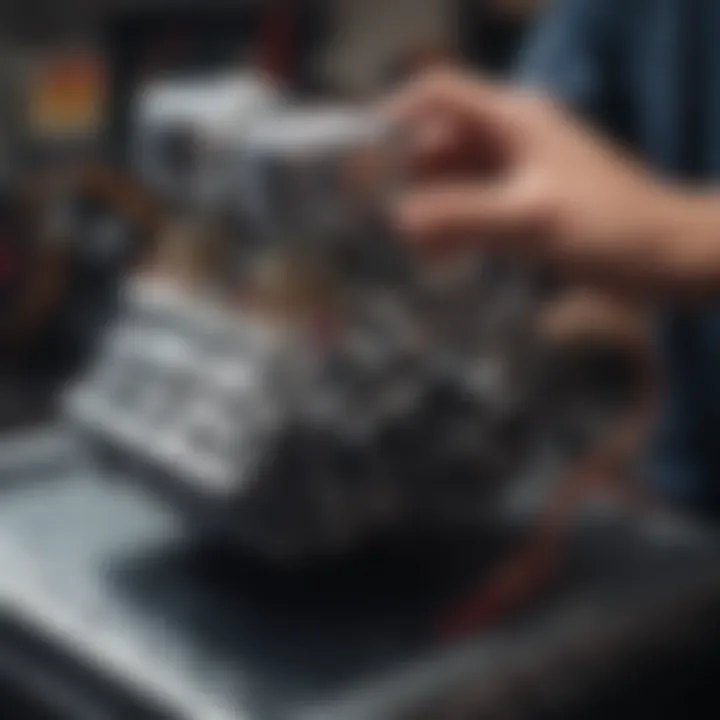Ultimate Nitrous Kits Guide for 350 Small Block Engines


Intro
Nitrous oxide systems have gained popularity among automotive enthusiasts, specifically those with 350 small block engines. These systems enhance engine performance by injecting nitrous oxide, providing a significant increase in horsepower. Understanding the intricacies of nitrous kits is essential for optimizing performance and ensuring safety.
This guide delves into various aspects of nitrous kits. We will explore different types of systems available, key components, and installation processes. Additionally, we will discuss performance implications, safety considerations, and tuning methodologies. This comprehensive resource aims to arm both professionals and car enthusiasts with the knowledge necessary to make informed decisions regarding nitrous oxide systems.
Key areas of focus include:
- Overview of nitrous kit types
- Detailed components used in nitrous systems
- Installation step-by-step guide
- Performance analysis and tuning tips
- Safety measures for effective usage
By synthesizing this information, readers can gain a deeper understanding of how nitrous kits can elevate their small block engines to new heights.
Understanding Nitrous Oxide Systems
Understanding Nitrous Oxide Systems is crucial for those keen on maximizing the performance of their 350 small block engines. Nitrous oxide, often referred to simply as nitrous, is a gas that can substantially enhance engine power when properly utilized. Its role in the performance tuning landscape cannot be overstated, as it offers a significant power boost without requiring major modifications to the engine itself. This section aims to provide foundational knowledge on nitrous oxide systems, emphasizing their components, functionality, and integration into a performance framework.
What is Nitrous Oxide?
Nitrous oxide is a colorless gas commonly used as an aerosol propellant and a recreational drug. However, in the world of automotive performance, it serves a very different purpose. It is chemically represented as N₂O and is known for its ability to increase the rate of combustion in an engine. When injected, nitrous oxide decomposes under high temperature, releasing additional oxygen. This extra oxygen allows for more fuel to combust, resulting in increased power output. It is particularly effective in naturally aspirated engines, like the 350 small block, because it can provide a boost without the costs or complexities associated with supercharging or turbocharging.
Nitrous oxide is stored under high pressure in a specially designed bottle. The system is activated with a switch or button, allowing for controlled delivery into the engine during operation. The ability to modulate nitrous injection is one of its primary advantages, making it easy for drivers to adjust power levels to suit various driving conditions or preferences.
The Chemistry Behind Performance Enhancement
To fully appreciate the performance enhancement provided by nitrous oxide systems, one must understand some basic chemical principles. The decomposition of nitrous oxide into nitrogen and oxygen occurs at approximately 570 degrees Fahrenheit. When injected into the combustion chamber, the added oxygen facilitates a more complete fuel burn. This is beneficial as it improves efficiency and reduces emissions compared to traditional combustion methods.
Increasing the amount of air-fuel mixture in the engine creates more horsepower. For example, if a truck with a 350 small block engine normally produces 300 horsepower, adding a nitrous oxide system can increase that figure dramatically, often by 30 to 50 percent or more, depending on the setup. However, this does come with limits. It is crucial to ensure that the engine is capable of handling the increased power to avoid damaging it.
The chemistry involved also underscores the necessity for proper tuning. When increasing the air intake, the fuel mixture must be adjusted accordingly to maintain optimal performance. Failure to do so can lead to issues such as detonation or engine knock, which can be catastrophic for performance and longevity.
"Understanding the fundamental chemistry of nitrous oxide allows users to optimize their engines for increased performance without compromising reliability."
Addressing these aspects ensures that enthusiasts can enjoy the benefits of nitrous oxide while minimizing risk. With the proper knowledge, users can effectively navigate the balance between power enhancement and engine safety.
Types of Nitrous Kits
Understanding the various types of nitrous kits is essential for maximizing the performance of a 350 small block engine. Each kit type offers distinct benefits, configurations, and considerations which can affect your engine’s output. The choice between wet and dry systems, for example, is a fundamental decision that impacts not only performance gains but also engine reliability and maintenance. This section aims to provide a detailed overview of the nitrous kits available, helping enthusiasts and professionals make informed decisions about their installations.
Wet Nitrous Kits
Wet nitrous kits operate by mixing fuel and nitrous oxide before it enters the engine's intake manifold. In these systems, a solenoid controls the release of both gases simultaneously. Because they provide additional fuel, wet kits are less likely to cause lean conditions in the engine, making them a popular choice for those seeking high power gains.
Some advantages of wet nitrous kits include:
- Fuel enrichment: The mixing of fuel helps maintain proper air-fuel ratios under high-load conditions, reducing the chance of engine knock.
- Higher power output: These kits tend to produce larger power increases compared to dry systems, especially when tuned properly.
However, there are drawbacks to consider:
- Complex installation: Wet kits often require more components, which can complicate installation.
- Higher maintenance: More moving parts mean increased potential for issues and maintenance needs.
Dry Nitrous Kits
In contrast, dry nitrous kits inject nitrous oxide alone, relying on the engine's fuel system to deliver the necessary extra fuel during operation. This method is simpler since it does not involve mixing, but it also presents challenges.
Key features of dry nitrous kits include:
- Simplicity: With fewer components required, installation is generally straightforward.
- Fitting into existing systems: They can be used with factory fuel systems as the added fuel comes from standard injectors.
On the downside, dry kits have their limitations:
- Risk of a lean condition: If the fuel system cannot deliver enough fuel, this can lead to serious engine damage due to lean conditions.
- Lower power gains: Compared to wet systems, dry kits usually produce less power under similar conditions.
Plate vs. Direct Port Systems
When choosing between plate and direct port nitrous systems, it’s crucial to understand how each system delivers nitrous to the engine.
Plate systems involve a single plate that mounts between the carburetor and the intake manifold. This design distributes nitrous oxide and fuel to all cylinders simultaneously. Benefits include:
- Ease of installation: Plates are typically easier to install compared to direct port systems.
- Portability: They are often lighter and less complex.
However, plate systems may not provide the same efficiency as direct port systems, where nitrous and fuel are injected directly into each cylinder via individual nozzles. This method offers distinct advantages:
- Optimized performance: Direct port systems allow for precise tuning, as each cylinder receives its own nitrous supply.
- Better consistency: Improved distribution across cylinders helps in achieving more uniform power gains.
This section has outlined the fundamental types of nitrous kits available for 350 small block engines. Understanding their characteristics and trade-offs enables enthusiasts to select a system that aligns with their performance goals and engine capabilities.
Key Components of a Nitrous Kit
Nitrous oxide systems include essential components that work in harmony to enhance engine performance. Understanding these key components can help you make informed decisions when purchasing and installing a nitrous kit. Each part plays a critical role in ensuring that the nitrous oxide is effectively delivered to the engine, maximizing power output while maintaining safety and efficiency.


Nitrous Bottle
The nitrous bottle is a crucial element of any nitrous oxide system. It serves as the storage vessel for the nitrous oxide itself, containing the gas under high pressure. Typically made from lightweight aluminum or composite materials, the design of the bottle ensures durability and ease of handling.
When using a nitrous bottle, it is vital to consider the following aspects:
- Capacity: Different bottles offer various capacities, influencing how long the nitrous can be used before needing a refill. Common sizes are 10, 15, or 20 pounds.
- Pressure Regulation: Maintaining the correct pressure is essential for consistent performance, so having a pressure gauge attached to the bottle is advisable.
- Mounting Location: The positioning of the nitrous bottle is important for effective operation. Many enthusiasts choose to mount it securely in the trunk or a designated area within the engine bay. This must be done carefully to ensure proper access during refills and routine checks.
Solenoids and Lines
Solenoids act as the electronic gates that control the flow of nitrous oxide from the bottle to the engine. When the driver activates the system, solenoids open to allow the nitrous to enter the fuel stream. Understanding the role of solenoids and lines can improve both performance and safety.
Several points to think about include:
- Quality of Solenoids: Investing in high-quality solenoids can prevent issues associated with leaks and inconsistent flow.
- Line Routing: Properly routing the lines minimizes the risk of kinks and damage, ensuring a steady and reliable supply of nitrous oxide.
- Electrical Connections: Solenoids require appropriate wiring to function correctly. Poor connections can lead to failures, so ensure all connections are secure and insulated.
Nozzles and Jets
Nozzles and jets are the components responsible for mixing the nitrous oxide with the engine's fuel and air. They play a significant role in determining the exact amount of nitrous that enters the combustion chamber. Understanding their function is key to optimizing performance.
Key considerations include:
- Jet Sizing: Different jet sizes allow for varying levels of nitrous delivery. Selecting the right size is essential for achieving your desired power output without harming the engine.
- Placement of Nozzles: The location of the nozzles impacts how well the nitrous mixes with the fuel. Usually, they are placed in the intake manifold or directly in front of the intake valves for better distribution.
- Material Quality: High-quality materials for jets and nozzles help prevent wear and tear from the high pressures and temperatures experienced during operation.
It's critical to remember that the interaction between these components matters. A well-designed nitrous kit can only perform at its best if all key elements are compatible and correctly installed.
Installation Considerations
When upgrading a 350 small block engine with a nitrous kit, installation considerations are crucial. Proper installation ensures the system operates effectively, achieving optimal performance while minimizing the risk of damage to the engine. It encompasses various aspects such as preparation, the actual installation process, and awareness of possible pitfalls. Understanding these elements will play a significant role in maximizing the benefits of the nitrous oxide system.
Pre-Installation Checklist
Before diving into installation, it is essential to go through a pre-installation checklist. This checklist helps to identify necessary tools, components, and safety measures. The following points are key aspects to review:
- Ensure All Necessary Parts Are Available: Confirm the nitrous kit includes the nitrous bottle, solenoids, lines, nozzles, and jets.
- Review Engine Specifications: Understand the specifications of the 350 small block engine to ensure compatibility.
- Gather Tools: Have the appropriate tools ready, including wrenches, screwdrivers, electric drills, and safety goggles.
- Electrical Connections: Check that all needed electrical connections can be made without issues.
- Read Manufacturer Instructions: Familiarize yourself with the installation manual provided by the kit manufacturer.
A thorough pre-installation checklist lays the groundwork for a successful installation, helping to minimize issues that might arise during the process.
Step-by-Step Installation Process
The step-by-step installation process for a nitrous kit involves several stages. Each step requires careful execution:
- Preparation of the Engine Bay: Clean the area where the nitrous system will be installed. Remove any dirt or debris to ensure a smooth process.
- Mounting the Nitrous Bottle: Secure the nitrous bottle in a safe location within the vehicle. The mounting kit provided with the nitrous kit will usually come with bolts and brackets.
- Routing the Lines: Carefully route the nitrous feed lines from the bottle to the solenoids and ultimately to the intake system. Make sure the lines are protected from high heat.
- Installing Solenoids: Mount the solenoids according to the manufacturer's instructions. Connect the nitrous lines to the solenoids ensuring tight seals to prevent leaks.
- Nozzle and Jet Installation: Install the nozzles in the intake manifold. Jet selection must align with the desired power increase and the engine's tuning.
- Electrical Connections: Connect the solenoids to the ignition system. This connection is critical for ensuring the nitrous system activates only when needed.
- Final Inspection: Once everything is connected, inspect all lines and connections for proper installation before closing up the engine bay.
Following these steps carefully will enhance performance and keep the engine operational under nitrous conditions.
Common Installation Mistakes
Even with careful planning, some common installation mistakes can arise. Knowing these mistakes can help you avoid them:
- Improper Bottle Mounting: Failing to secure the nitrous bottle properly can lead to excessive vibrations, risking damage.
- Neglecting Electrical Ratings: Using electrical components not rated for the current requirements may lead to failures.
- Incorrect Jet Selection: Installing the wrong jets can either underperform the engine or lead to catastrophic engine damage.
- Overlooking Leak Checks: Not checking for leaks in the nitrous lines can result in loss of nitrous and unsafe conditions.
- Skipping the Final Inspection: Missing this step can result in overlooking critical connections and seals.
Avoiding these pitfalls is imperative to ensure the longevity of both the nitrous kit and the engine.
Tuning Your Engine for Nitrous
Tuning your engine for nitrous is a crucial step in maximizing the benefits of nitrous oxide systems. A proper tune ensures that the engine can handle the additional power and maintains reliability. The process involves optimizing air-fuel mixtures, adjusting ignition timing, and ensuring that all components of the engine work harmoniously when the nitrous is activated. Without proper tuning, the engine runs the risk of detonation, poor performance, or significant damage.
Fuel and Air Management
Managing fuel and air adequately is essential when incorporating nitrous. The engine must receive an ideal mixture of fuel and air to achieve a proper combustion process, especially under added pressure from nitrous.
- Air-Fuel Ratios: Typically, when nitrous is introduced, the air-fuel ratio must be adjusted to accommodate the extra oxygen supplied by the nitrous gas. A common target is to maintain a ratio of around 12.5:1 to 13.0:1 for peak performance.
- Fuel Injector Size: Depending on the power levels expected, larger fuel injectors may be necessary to deliver the required fuel volume. This adjustment ensures that the engine receives sufficient fuel to match the increased air load.
- Fuel Pump Capability: The fuel pump must also be capable of handling the added demand. An upgrade to a higher capacity pump is often required to supply consistent pressure and volume during nitrous activation.
Optimizing these elements contributes to both immediate performance gains and long-term engine health. Overly lean conditions can cause engine knock, while excessively rich mixtures can lead to incomplete combustion, affecting performance negatively. Achieving balance requires careful measurement and calibration during the tuning process.
Adjusting Timing and Fuel Ratios
Timely adjustments to ignition timing and fuel ratios are critical when tuning for nitrous. The nitrous addition alters combustion dynamics requiring these adjustments.
- Ignition Timing: When nitrous is introduced, a slight retarding of ignition timing is advisable. This adjustment helps minimize the risk of detonation. Most experienced tuners suggest pulling 2 to 4 degrees of timing out of the engine for nitrous applications.
- Fuel Ratios: As previously mentioned, the optimal fuel ratios shift under nitrous conditions. Tuning the engine's electronic control unit (ECU) to reflect these changes is vital. The tuning process might involve using a wideband oxygen sensor to continuously monitor the air-fuel ratio during nitrous use.
- Detonation Management: Implementing knock sensors can help detect any pre-ignition or knock events, allowing further refinement of timing adjustments. This method aids in ensuring the engine remains within safe operating conditions, thus avoiding catastrophic failures.
Performance Implications
Understanding performance implications is crucial when considering nitrous kits for 350 small block engines. These systems are designed to increase power output significantly, but they come with considerations that must be evaluated thoroughly. Knowing how nitrous systems influence engine behavior aids in making informed decisions about modifications and expected outcomes.
Power Gains and Limitations
Nitrous oxide can lead to impressive power gains; typically, users can expect an increase of anywhere from 25 to 150 horsepower, depending on the kit and setup. This boost can transform a standard small block engine into a formidable competitor on the racetrack or a more spirited performer on the streets.


However, it’s essential to recognize the limitations of nitrous systems. The power gain largely depends on the engine's overall condition, existing modifications, and tuning. Over-reliance on nitrous can lead to a false sense of security regarding horsepower. Drivers must consider the potential drawbacks, too—if pushed beyond safe limits, nitrous can lead to engine knock, pre-ignition, or even catastrophic failure. Therefore, it is vital to manage expectations and utilize nitrous kits as part of a broader tuning strategy.
Effects on Engine Longevity
Installing a nitrous system can put additional strain on engine components, which could affect longevity. While nitrous can enhance performance, it can also increase cylinder temperatures and pressures. Addressing these factors is critical to ensuring the engine remains reliable over time.
To mitigate potential damage, several practices should be employed:
- Ensure appropriate tuning to adapt mixture ratios and ignition timing.
- Use higher-octane fuels, which can help resist knocking.
- Regularly inspect and maintain engine components such as spark plugs, fuel injectors, and valves, as increased performance demands they operate optimally.
Having a nitrous system doesn’t preclude owners from enjoying a prolonged lifespan for their engines. With the right precautions and awareness, it is possible to enjoy enhanced performance while minimizing negative effects on engine health.
"The key to maximizing nitrous performance lies in proper tuning and understanding the engine's capabilities."
Safety Protocols
Understanding and implementing safety protocols when working with nitrous kits is vital for both performance and protection. Nitrous oxide, while effective at increasing engine power, also presents inherent risks if not handled correctly. Neglecting these protocols can lead to fines, injuries, or damage to vehicles. Therefore, maintaining caution and respect for the technology is crucial.
Handling Nitrous Safely
When handling nitrous oxide, proper procedures are essential to ensure safety.
- Personal Protective Equipment (PPE): Always wear appropriate PPE. This includes safety glasses and gloves. These items help protect against accidental discharges or leaks.
- Storage Conditions: Store nitrous bottles in a cool, dry place, away from direct sunlight and heat sources. Self-ignition can occur at high temperatures.
- Regular Checks: Regularly inspect your nitrous bottles and connections for leaks. This can be done using soapy water; bubbles appear if there is a leak.
- Know the Contents: Be aware of what is inside the nitrous container. Understand if it is pure nitrous or a blend. Each requires different handling.
- Safe Operation: When filling nitrous bottles, do so in a well-ventilated area to prevent the accumulation of gas, which can be hazardous if inhaled.
- Never Shake the Bottle: This can damage the internal components and lead to failure. Always keep the bottle upright during transport and handling.
Emergency Procedures
In the event of an emergency involving nitrous oxide, it is essential to know the correct actions to take.
- Evacuate Area: If a major leak is detected, immediately evacuate the area and alert others.
- Do Not Ignite: In the presence of a leak, avoid all ignition sources. This includes open flames, sparks, or static electricity.
- Ventilation: Increase ventilation in the area to allow the gas to dissipate. Open windows and doors if possible.
- Contact Emergency Services: If a person has inhaled nitrous oxide, call emergency services immediately. Administer fresh air and monitor their condition while waiting for help.
- Inform Arriving Help: When emergency responders arrive, inform them of the nitrous oxide presence and the specifics of the incident.
"Nitrous oxide can be hazardous; proper handling and emergency readiness are key to preventing accidents."
Optimal Use Scenarios for Nitrous Kits
Understanding the optimal use scenarios for nitrous kits is essential to fully appreciate their effectiveness and applications. This section explores how nitrous systems can enhance performance in different contexts, particularly focusing on racing and street use. Recognizing when and how to deploy nitrous oxide systems can maximize benefits and minimize potential risks.
Racing Applications
In racing, nitrous oxide systems provide crucial power boosts crucial for enhancing performance. These kits allow drivers to achieve higher horsepower without the need for extensive engine modifications. Applications in competitive racing typically focus on drag racing and circuit racing. Here, nitrous systems must be reliable and efficient.
- Drag Racing: In drag racing, every millisecond counts. Nitrous kits can dramatically reduce acceleration times. The rapid increase in horsepower can shorten quarter-mile times, making nitrous a preferred choice among competitors. However, there should be considerable focus on tuning to ensure optimum performance during the race.
- Circuit Racing: For circuit racing, managing a nitrous system requires careful balance. It’s not just about raw power; consistent performance over several laps is critical. Drivers often use nitrous strategically during key moments, such as overtaking or climbing steep inclines. This ensures they maximize the benefits during critical sections of the race.
Using nitrous in these scenarios does not come without its considerations. Ensuring proper tuning and understanding how to engage and disengage nitrous safely is critical to avoid potential engine damage.
Street Use Considerations
Nitrous kits are not only reserved for racing. Many enthusiasts consider using nitrous systems in daily-driven vehicles as well. There are a few factors to keep in mind, especially regarding safety and legality.
- Daily Driving: While it can be exciting to have a quick power boost for street driving, reliability becomes a priority. Using nitrous sparingly and ensuring that the car is adequately tuned for regular use makes it a viable option. Drivers should avoid excessively using nitrous on public roads, as it can lead to unwanted strain on the engine.
- Legal Considerations: Many regions have laws regarding the use of nitrous systems on public roads. Familiarizing oneself with local regulations is essential. Ensuring that the nitrous system is installed correctly and adheres to legal requirements will prevent future legal issues.
- Safety: Engine stress is a primary concern. Drivers should consider how often to utilize nitrous in everyday driving to maintain engine health. Proper installation of the system will support safe use and longevity.
In both racing and street use scenarios, the effective utilization of nitrous oxide kits will depend on a clear understanding of the vehicle, the driving conditions, and a commitment to safety and legality.
Utilizing nitrous systems effectively involves consideration of when and how to engage them, ensuring maximum safety and performance.
Ultimately, whether in a racing context or for street applications, proper planning and knowledge can lead to an enhanced driving experience.
Cost-Benefit Analysis of Nitrous Kits
Understanding the cost-benefit of adopting nitrous kits offers valuable insight for enthusiasts contemplating performance enhancements on their 350 small block engines. This section delineates the financial commitments against the performance boost these systems may provide. A clear grasp of these dynamics is vital for making informed decisions that align with both budget and performance expectations.
Initial Investment vs. Performance Gains
When evaluating nitrous kits, the initial investment is a significant aspect. Costs can vary substantially based on type and quality. On average, a basic wet or dry nitrous kit may cost between $300 to $1,000. However, top-end systems, particularly with high-performance features, can reach up to $2,000 or more. This price typically includes not only the nitrous components but also any necessary supplementary equipment like fuel system modifications or tuning tools.
The next consideration is the performance gains. Nitrous systems are well-known for their ability to increase horsepower significantly. Users often report gains from 50 to 200 extra horsepower depending on the kit and configuration. For instance, a wet nitrous kit can deliver a substantial power boost when the engine is properly tuned and managed. The potential for increased throttle response and acceleration can be particularly appealing for racers or those seeking enhanced street performance.
Here are some considerations regarding initial investments and performance:
- Budget Constraints: Determine how much can be allocated for the nitrous setup without straining finances.
- Return on Investment (ROI): Assess how the performance gains translate into real-world advantages, such as better track times or improved street usability.
- Long-Term Goals: Consider whether the goal is for short-term racing purposes or long-term street driving, as this can influence both kit selection and tuning.
Maintenance and Refills
After installation, consideration shifts toward ongoing maintenance and the costs associated with refilling the nitrous bottle. Unlike some performance enhancements, nitrous oxide systems usually require minimal routine maintenance. However, regular checks are essential. The primary maintenance concern includes inspecting the nitrous lines and solenoids for any signs of wear or leaks which can compromise system efficiency.
Every time the nitrous is used, the bottle needs refilling. The cost of refills can vary based on local suppliers and market prices but typically ranges from $30 to $60 for a standard refill. Users should factor this recurring expense into their overall cost of ownership. Additionally, users must consider the convenience of refilling nitrous bottles, especially if frequent use is part of their routine.
Moreover, it is important to account for potential upgrades. If there is a goal of increasing power output further, additional investments into tuning, fuel systems, or even higher-capacity nitrous setups could be required. As systems can be built upon or modified, understanding these dynamics can lead to wiser financial decisions over time.
Key Takeaway: The financial analysis of nitrous kits is crucial for anyone considering this modification. Balancing the upfront costs with expected performance improvements and future expenses is essential for long-term satisfaction.


Comparing Nitrous Kits to Other Performance Enhancements
When enhancing engine performance, enthusiasts often consider various methods, including nitrous kits, supercharging, and turbocharging. Understanding the differences and specific benefits of these performance enhancement systems is crucial. It aids in selecting the best option for individual needs and application. Furthermore, knowing how these systems compare can help in optimizing the overall performance of a vehicle.
Supercharging vs. Nitrous
Supercharging uses a belt-driven compressor to increase air intake into the engine. This process creates higher manifold pressure, leading to a significant boost in horsepower and torque. Superchargers offer a steady power increase throughout the entire RPM range. However, they require substantial engine modifications and can put additional strain on the engine components.
On the other hand, nitrous kits offer a different method of power enhancement. They inject nitrous oxide directly into the combustion chamber, allowing more fuel to be burned, resulting in quick power bursts. The ease of installation of specific kits makes them appealing to many enthusiasts. Yet, nitrous systems usually require careful tuning and can lead to potential engine damage if not managed well.
Key Considerations:
- Power Delivery: Superchargers deliver consistent power, while nitrous provides intermittent bursts.
- Installation Complexity: Superchargers need more modifications than nitrous kits.
- Cost Factors: Initial investment in a supercharger can be higher, but performance gains may offset costs in the long run.
Turbocharging vs. Nitrous
Turbocharging relies on exhaust gases to spin a turbine, increasing the intake air pressure. This method enhances efficiency and offers a significant power increase once the turbo spools up. However, there can be a noticeable lag, especially in smaller engines. The complexity of installation and the need for an intercooler for optimal performance are additional challenges.
In contrast, nitrous kits can be activated to provide immediate power without the lag associated with turbochargers. They remain simpler to install compared to a full turbo setup. Yet, the use of nitrous involves risks such as potential engine damage if the system is not precisely tuned or monitored.
Key Comparisons:
- Spool Time: Turbochargers may lag, while nitrous delivers immediate power.
- Installation Efforts: Nitrous is generally easier to install than a turbo system.
- Potential Risks: Both systems come with risks, but proper management of nitrous is crucial to avoid significant damage.
"Choosing between nitrous, supercharging, and turbocharging ultimately depends on your specific performance goals and how you plan to use your vehicle. Each system has its advantages and drawbacks."
In summary, while nitrous kits offer unique benefits with straightforward installation and immediate power gains, supercharging and turbocharging present their complexities and consistency in power delivery. Careful analysis of these options is essential for any automotive enthusiast or builder aiming for performance enhancements.
Real-World Applications of Nitrous Kits
The application of nitrous kits extends far beyond theoretical benefits. Understanding how these systems perform in real-world scenarios provides valuable insight for automotive enthusiasts and professionals alike. Notably, nitrous oxide systems are becoming popular in various performance contexts, from competitive racing to street application. Their ability to deliver significant power gains in a controlled manner makes them an attractive option.
One of the primary advantages of nitrous kits is their versatility. They can effectively boost performance in multiple settings. Whether in a drag race or during daily driving, nitrous oxide enhances engine output without the need for a complete overhaul of engine components. However, using nitrous requires careful consideration of the vehicle's existing systems to ensure compatibility.
Case Studies of Successful Installations
Numerous enthusiasts have successfully implemented nitrous kits, demonstrating their effectiveness. For example, a Chevrolet Camaro owner decided to install a Nitrous Express kit. This kit included a wet system that injected nitrous directly into the intake manifold, optimizing fuel delivery and combustion efficiency. After installation, the car saw an increase in horsepower, bringing the performance level significantly closer to professional racing standards.
Another case study involves a Ford Mustang equipped with a ZEX nitrous system. The owner reported a seamless integration with their existing engine management system, allowing for a rich mixture of fuel and nitrous. These results translated to quicker quarter-mile times. Such installations highlight the capability of nitrous systems to elevate performance without causing damage or excessive wear on the engine components.
Feedback from Users
User feedback provides critical insights into the practicality of nitrous kits on the market. Many users note the immediate power increase after installation, alongside the thrill of experiencing enhanced performance. For instance, online forums reveal that many drivers appreciate the ease of engagement through a simple switch. Users have mentioned that the systems' reliability when tuned properly adds to the overall driving experience.
However, some concerns arise. Some users express caution regarding the necessity of maintenance and tuning. Regular refills of nitrous and ensuring the system is leak-proof is crucial for long-term success. Additionally, users also emphasize understanding the limits of their engines. Over-relying on nitrous can lead to complications if not managed correctly.
Feedback from various platforms—such as Reddit and Facebook—further supports the effectiveness and common challenges associated with nitrous systems. Users often share their tuning experiences and advice on optimizing performance, enriching the community's collective knowledge.
"When utilized properly, nitrous systems can transform an ordinary vehicle into a high-performance machine. Just ensure you understand the system before you hit the gas."
In summary, real-world applications of nitrous kits highlight both the benefits and considerations essential for anyone looking to enhance their vehicle's performance. The case studies illustrate practical results, while user feedback emphasizes the importance of proper tuning and maintenance.
Future of Nitrous Technology
The future of nitrous technology holds significant promise for automotive performance enthusiasts and prospective buyers. As this sector evolves, innovations in design and application may offer new advantages that improve both performance and safety. Understanding these changes is important for any individual looking to enhance their 350 small block engine effectively.
Trends in Performance Modifications
In the realm of performance modifications, several trends are emerging. First, there is a growing preference for integrated systems that combine multiple forms of power enhancement. Gearheads now often seek to combine nitrous oxide with superchargers or turbochargers, optimizing the power curve while maintaining driveability. This approach aims to harness the benefits of various technologies to achieve greater horsepower without sacrificing reliability.
Additionally, the focus is shifting towards more user-friendly systems. Companies are designing nitrous kits that incorporate digital controls and tuning software. These systems provide real-time feedback on performance, allowing for precise adjustments to timing and fuel delivery. This level of customization caters to both seasoned tuners and newcomers.
Moreover, there's a noticeable interest in lightweight materials for components. Reducing weight helps to improve vehicle dynamics, which is crucial in racing applications. As a result, manufacturers are exploring composite materials for nitrous bottles and associated hardware. Such advancements not only contribute to enhanced performance but also improve safety standards for high-powered applications.
Advancements in Nitrous Technology
The advancements in nitrous technology are particularly noteworthy. One significant improvement is the development of high-flow solenoids. These components allow for faster and more efficient delivery of nitrous oxide to the engine. Enhanced solenoid design translates to a quicker response time, giving drivers the ability to engage nitrous more effectively when needed.
Additionally, innovations in nozzle design have led to better distribution of nitrous within the intake manifold. This means that each cylinder receives a more balanced mix, improving throttle response and overall power output. Enhanced nozzle technology enhances combustion efficiency, which can result in not only greater power but also improved fuel economy when nitrous is not in use.
Furthermore, safety features in nitrous systems are expanding. New bottles come equipped with advanced pressure relief valves. These valves automatically release gas if internal pressure exceeds safe limits, preventing potential explosions and ensuring safer operation. Early sensor technology is also being introduced, alerting drivers to potential issues before they become critical.
"The evolution of nitrous technology is not just about power; it’s about enhancing safety and versatility in performance applications."
Culmination
The conclusion of this article highlights the significance of nitrous oxide systems for 350 small block engines. Understanding these systems is crucial for automotive enthusiasts and professionals who aim for enhanced engine performance. Nitrous oxide allows for increased power output and responsiveness when managed appropriately.
Summary of Key Points
Throughout the article, various critical aspects of nitrous kits were explored, including:
- Types of Nitrous Kits: Wet and dry kits, each with distinct characteristics and applications.
- Key Components: A clear understanding of the nitrous bottle, solenoids, lines, nozzles, and jets is essential for proper installation and functionality.
- Installation Considerations: Proper steps and common pitfalls can ensure a successful installation of a nitrous system.
- Tuning: Proper tuning of fuel and timing settings is necessary to maximize performance while maintaining engine integrity.
- Safety Protocols: Emphasizing the importance of handling nitrous safely and knowing emergency procedures.
- Future Trends: Insight into advancements in nitrous technology and future integration in performance modifications.
Final Thoughts on Nitrous Systems
In the realm of performance enhancements, nitrous systems provide a unique approach to increasing horsepower effectively and affordably. Their simplicity in installation juxtaposed with significant performance gains makes them an attractive option for many car enthusiasts. However, the potential downsides, such as the impact on engine longevity and the need for meticulous tuning, must be considered. As technology advances, nitrous systems will likely evolve, offering even greater efficiency and safety features. With the right knowledge and approach, enthusiasts can harness the power of nitrous oxide, transforming their 350 small block engines to meet their performance aspirations.







